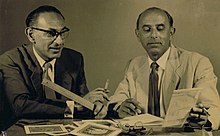 A graphic designer working digitally on a logo design | |
| Occupation | |
|---|---|
| Names | Graphic designer |
Occupation type | Profession |
Activity sectors | Advertising, book design, branding, illustration, page layout, typography, webcomic, web design, programming, digital animation, 3D modeling |
| Description | |
| Competencies | Technical knowledge, cultural relevance |
Related jobs | Production artist, graphic artist, website designer, desktop publishing |


A graphic designer is a professional who practices the discipline of graphic design, either within companies or organizations or independently. They are professionals in design and visual communication, with their primary focus on transforming linguistic messages into graphic manifestations, whether tangible or intangible.[1][2] They are responsible for planning, designing, projecting, and conveying messages or ideas through visual communication.[3] Graphic design is one of the most in-demand professions with significant job opportunities, as it allows leveraging technological advancements and working online from anywhere in the world.[4]
Generally, a graphic designer works in areas such as branding, corporate identity, advertising, technical and artistic drawing, multimedia, etc. It is a profession that exposes individuals to various academic fields during their university career,[5][6][7] because they need to understand human anatomy, psychology, photography, painting and printing techniques, mathematics, marketing, digital animation, 3D modeling, and some professionals even complement their skills with programming,[8] providing a comprehensive view of a company by addressing the three essential factors evaluated: structure, team, and product.[9]
Graphic designers can work with singular clients or multiple people including collaborations. This is where communication is crucial because misunderstandings can lead to setbacks. [10]
Professional requirements for graphic designers vary from one place to another. Designers must undergo specialized training, including advanced education and practical experience (internship) to develop skills and expertise in the workplace, which is necessary to obtain a credential that allows them to practice the profession.[11][12] Practical, technical, and academic requirements to become a graphic designer vary by country or jurisdiction, although the formal study of design in academic institutions has played a crucial role in the overall development of the profession.[13][14][15]
- ^ Flavin, Brianna (17 October 2023). "What Is Graphic Design? A Beginner's Guide to This Creative Career". Rasmussen University.
- ^ Jessica Helfand. "What is graphic design". AIGA. Retrieved 29 June 2009.
it is the art of visualizing ideas
- ^ Simmons, Liz; Beagle, Veronica (3 July 2023). "How To Become A Graphic Designer: A Step-By-Step Guide". Forbes.
- ^ Malinsky, Gili (15 March 2023). "This skill is in 'giant' demand—and can pay up to $145 an hour as a side hustle". CNBC.
- ^ Vise, Kristen. "An Interdisciplinary Approach to Graphic Design". College of Liberal Arts. Archived from the original on 14 April 2021. Retrieved 13 October 2021.
- ^ Castro Arbeláez, María Alejandra (14 September 2023). "Graphic design and psychology: how are they related?". La Mente es Maravillosa.
- ^ "The importance of geometry in graphic design". Universidad Intercontinental. 28 November 2017.
- ^ "What is the importance of web design for your audience?". Smart Insights. 3 January 2020.
- ^ "Business Model Canvas: Explained with Examples | Creately". creately.com. 20 June 2022. Retrieved 29 December 2023.
- ^ Cornish, K., Goodman-Deane, J., Ruggeri, K., & Clarkson, P. J. (2015). Visual accessibility in graphic design: A client–designer communication failure. Design Studies, 40, 176–195. https://doi.org/10.1016/j.destud.2015.07.003
- ^ Grey, Sheryl; Beagle, Veronica (3 July 2023). "Graphic Design Careers: A Complete Guide". Forbes.
- ^ Tompkins, Jeff; Beagle, Veronica (3 July 2023). "Bachelor's Degrees In Graphic Design: Everything You Need To Know". Forbes.
- ^ Quintela, Pedro. "From the shadow to the centre: Tensions, contradictions and ambitions in building graphic design as a profession" (PDF). University of Coimbra. Archived from the original (PDF) on 7 August 2022. Retrieved 7 August 2022.
- ^ Khaled Nabil, Al-Momani (25 August 2020). "Characteristics of Design as an Academic and Creative Discipline". Kne Social Sciences. Ural Federal University: 294–298. doi:10.18502/kss.v4i11.7560. S2CID 221710217.
- ^ Bravo, Rafael Ángel (4 March 2016). "Vigencia de la Bauhaus en la formación académica de los diseñadores gráficos" [Currency of the Bauhaus in the academic training of graphic designers] (in Spanish). Francisco José de Caldas District University. Archived from the original on 12 March 2022.